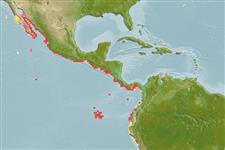Environment: milieu / climate zone / depth range / distribution range
Écologie
marin récifal; profondeur 0 - 18 m (Ref. 5227). Tropical; 30°N - 10°S, 120°W - 70°W
Eastern Pacific: Bahía Sebastían Vizcaino and the northern Gulf of California (Isla Angel de la Guarda and Puerto Lobos) to Peru, including the Galapagos Islands (Ref. 5590).
Taille / Poids / Âge
Maturity: Lm ? range ? - ? cm
Max length : 18.0 cm SL mâle / non sexé; (Ref. 28023); common length : 12.0 cm TL mâle / non sexé; (Ref. 55763)
Description synthétique
Morphologie | Morphométrie
Body cylindrical; head with cirri above the eyes, on the nape, and at the posterior edge of the anterior nostril; maxillary not protrusible; each jaw with one row of incisiform teeth; anal and dorsal fins elongated ; lateral line divided into two, independent, overlapping segments (Ref. 55763).
Adults prefer the surge zone of unprotected rocky headlands with steep slopes. They wedge themselves in crevices close to shore in shallow water, darting out to defend their territory. Diurnal feeders that graze on algae and sessile invertebrates, using their comb-like incisor teeth to scrape food (Ref. 28023). Oviparous. Eggs are demersal and adhesive (Ref. 205), and are attached to the substrate via a filamentous, adhesive pad or pedestal (Ref. 94114). Larvae are planktonic, often found in shallow, coastal waters (Ref. 94114).
Life cycle and mating behavior
Maturité | Reproduction | Frai | Œufs | Fécondité | Larves
Oviparous, distinct pairing (Ref. 205).
Thomson, D.A., 1987. Reef fishes of the Sea of Cortez. The rocky-shore fishes of the Gulf of California. The University of Arizona Press, Tucson. 302 p. (Ref. 5592)
Statut dans la liste rouge de l'IUCN (Ref. 130435)
Menace pour l'homme
Harmless
Utilisations par l'homme
Pêcheries: sans intérêt; Aquarium: Commercial
Plus d'informations
Taille/ÂgeCroissanceLongueur-poidsLongueur-longueurFréquences de longueursMorphométrieMorphologieLarvesDynamique des populations larvairesRecrutementAbondanceBRUVS
RéférencesAquacultureProfil d'aquacultureSouchesGénétiqueElectrophoresesHéritabilitéPathologiesTraitementNutrientsMass conversion
CollaborateursImagesStamps, Coins Misc.SonsCiguateraVitesseType de nageSurface branchialeOtolithesCerveauxVision
Outils
Articles particuliers
Télécharger en XML
Sources Internet
Estimates based on models
Preferred temperature (Ref.
123201): 20.3 - 29.1, mean 26.1 °C (based on 200 cells).
Phylogenetic diversity index (Ref.
82804): PD
50 = 0.5312 [Uniqueness, from 0.5 = low to 2.0 = high].
Bayesian length-weight: a=0.00955 (0.00505 - 0.01805), b=2.99 (2.83 - 3.15), in cm total length, based on LWR estimates for this species & (Sub)family-body (Ref.
93245).
Niveau trophique (Ref.
69278): 2.7 ±0.25 se; based on food items.
Résilience (Ref.
120179): Milieu, temps minimum de doublement de population : 1,4 à 4,4 années (Assuming tm=1 and Fec 100-1000).
Fishing Vulnerability (Ref.
59153): Low vulnerability (12 of 100).
Nutrients (Ref.
124155): Calcium = 82.9 [47.2, 125.0] mg/100g; Iron = 0.688 [0.441, 1.054] mg/100g; Protein = 18.7 [17.6, 19.6] %; Omega3 = 0.129 [0.087, 0.193] g/100g; Selenium = 22.1 [13.5, 38.2] μg/100g; VitaminA = 120 [41, 341] μg/100g; Zinc = 1.82 [1.31, 2.45] mg/100g (wet weight);
